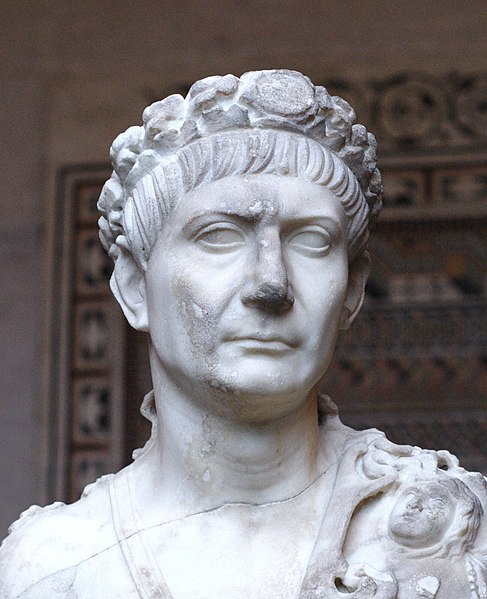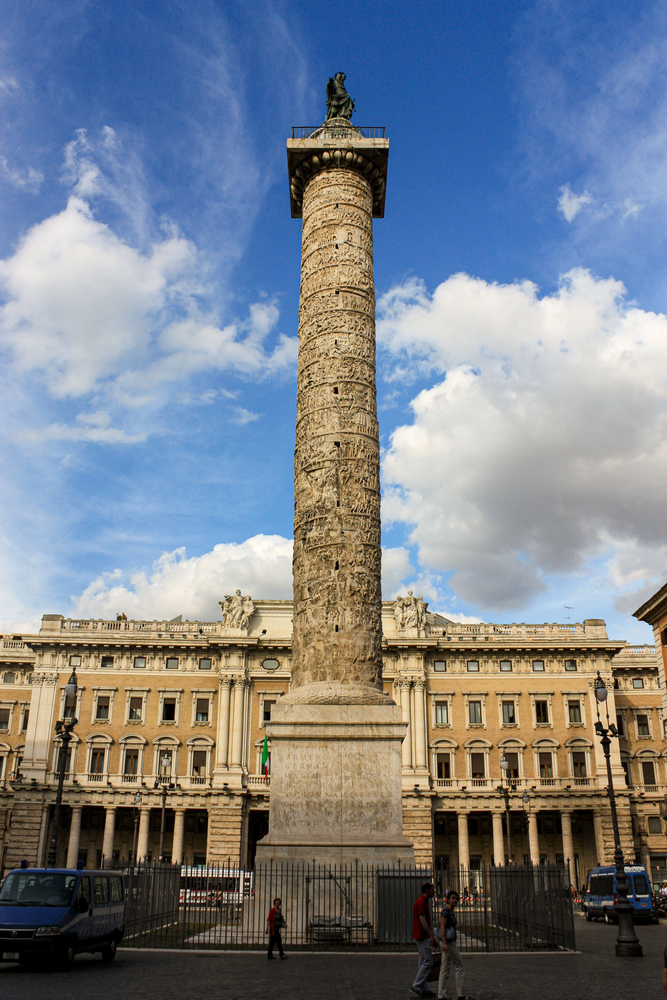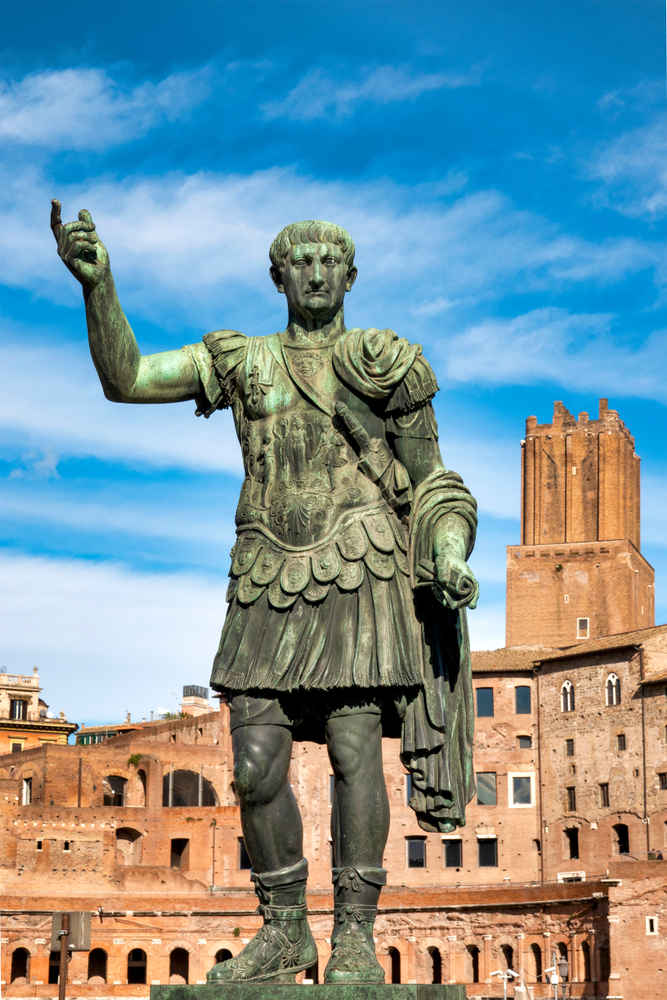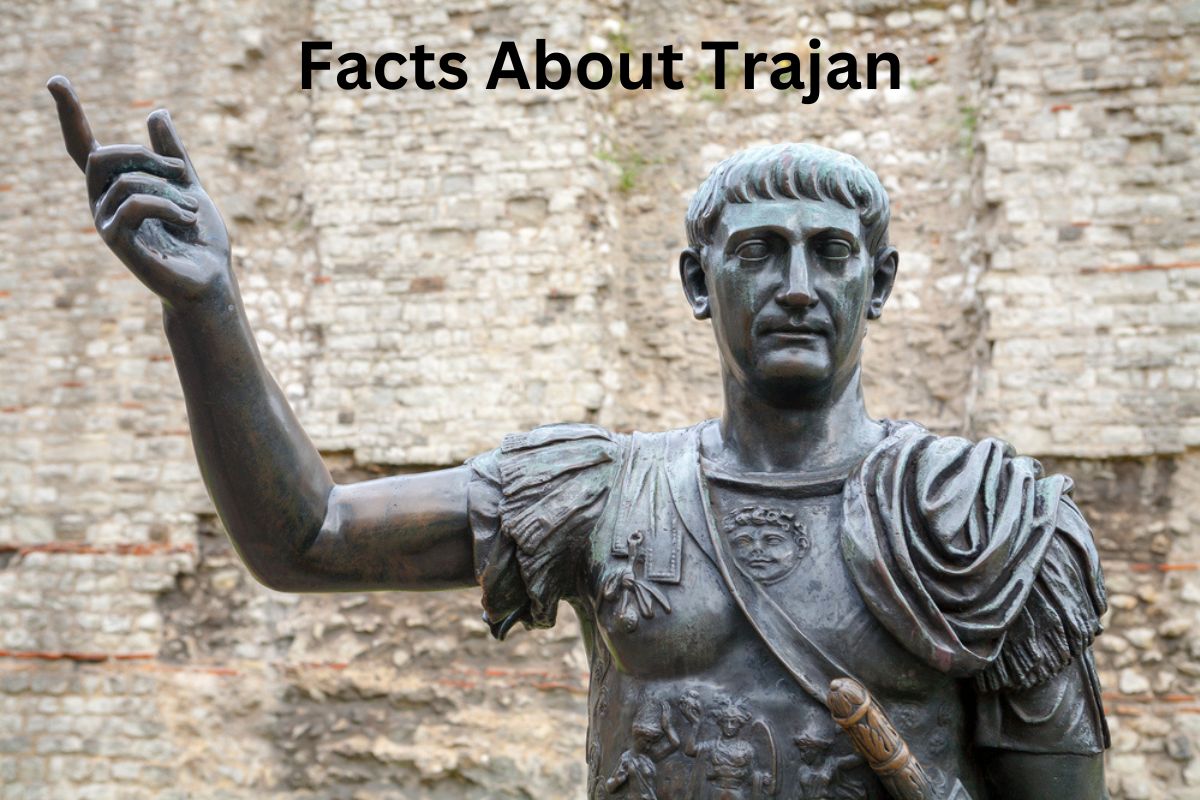Trajan, born in 53 AD in Hispania (modern-day Spain), was a Roman emperor from 98 to 117 AD. He was the first emperor born outside of Italy.
Trajan expanded the empire, led successful military campaigns, and constructed impressive structures like Trajan’s Forum and Column.
His reign brought relative peace, prosperity, and social welfare programs. Trajan died in 117 AD, leaving a lasting legacy on the Roman Empire.
Trajan Facts
1. Trajan was a Roman emperor who ruled from 98 to 117 AD
Trajan was born on September 18, 53 AD, in the Roman province of Hispania, which encompassed the Iberian Peninsula (modern-day Spain and Portugal). His birthplace is believed to be the city of Italica, near modern-day Seville.
Also Read: Trajan Accomplishments
Being born outside of Italy was a significant distinction for Trajan, as previous emperors were predominantly from Italian noble families. His non-patrician background made him relatable to the Roman people and helped him gain their support.

2. His full name was Marcus Ulpius Traianus, but he is commonly known as Trajan
Trajan’s full name was Marcus Ulpius Traianus. His family belonged to the equestrian class, which was a lower-ranking social class in Roman society. His father, Marcus Ulpius Traianus, served as a senator and had a successful military career.
This familial background likely influenced Trajan’s rise to power and his subsequent emphasis on military achievements.
Trajan’s ascendancy to the throne was facilitated by his military career. He demonstrated exceptional leadership skills and bravery, earning the respect and loyalty of his troops.
His successes in the military campaigns on the Danube frontier and in the eastern provinces of the Roman Empire propelled him to the position of emperor. His reputation as a competent general played a crucial role in securing the support of the Roman legions.
3. Trajan was the first Roman emperor to be born outside of Italy
Prior to Trajan, all the emperors of Rome hailed from Italy. Trajan’s birthplace in the Roman province of Hispania (modern-day Spain) marked a significant departure from this tradition. His birth in the city of Italica, near modern-day Seville, made him the first emperor to be born outside of Italy.
This distinction played a role in Trajan’s rise to power and his relationship with the Roman people. Being born in a province reflected the growing importance of regions beyond Italy within the Roman Empire. It helped Trajan establish a connection with the provinces and gain their support, as he was seen as representing the expanding reach and inclusivity of the empire.
4. During his reign, Trajan expanded the Roman Empire to its greatest territorial extent
Trajan’s most notable military conquest was the Dacian Wars (101-102 and 105-106 AD). The Dacians, a formidable enemy, posed a threat to the Roman Empire. Trajan led two expeditions against them, ultimately conquering the kingdom of Dacia (present-day Romania).
The spoils from the Dacian Wars, including gold and other valuable resources, enriched the Roman treasury and funded Trajan’s ambitious building projects.
5. Trajan is best known for his construction projects, particularly the building of Trajan’s Forum and Trajan’s Column in Rome
Trajan left a lasting architectural legacy through his construction projects. Trajan’s Forum, located in the heart of Rome, was a vast complex that included a market, administrative buildings, a basilica, and a grand column.

The centerpiece of the forum was Trajan’s Column, a towering monument adorned with a spiraling sculptural frieze depicting scenes from the Dacian Wars. The column served both as a propaganda tool, showcasing Trajan’s military achievements, and as a symbol of Rome’s power and dominance.
These architectural endeavors solidified Trajan’s reputation as a patron of the arts and an emperor who emphasized the grandeur of the Roman Empire.
6. Trajan was also known for his extensive public building programs throughout the Roman Empire
Trajan’s commitment to public building programs extended beyond Rome and encompassed various regions of the Roman Empire. He initiated ambitious infrastructure projects aimed at improving transportation, communication, and the overall quality of life.
Trajan’s extensive network of roads connected distant provinces and facilitated trade, military movements, and the efficient administration of the empire. He also constructed bridges, such as Trajan’s Bridge over the Danube River, which facilitated military campaigns and enhanced regional connectivity.
In addition, Trajan oversaw the construction of aqueducts to provide reliable water supply to cities and harbors to facilitate maritime trade.
7. Under Trajan’s rule, Rome experienced a period of relative peace and prosperity known as the Pax Romana (Roman Peace)
The Pax Romana, or Roman Peace, is often associated with the reign of Trajan. While conflicts and skirmishes continued to occur, Trajan’s military successes and effective governance brought relative stability to the Roman Empire.
This period of peace allowed for economic growth, agricultural prosperity, and cultural flourishing. Trade and commerce thrived, and the empire experienced a period of urban development and intellectual achievements.

8. Trajan implemented social welfare programs to benefit the Roman people
Trajan implemented social welfare programs to support the Roman people, particularly the underprivileged. One of his notable initiatives was the “alimenta” system. Through this program, the state provided financial assistance to impoverished children, ensuring they received education and sustenance.
The alimenta system aimed to alleviate poverty, promote social mobility, and create a more stable and educated citizenry. It demonstrated Trajan’s concern for the welfare of his subjects and his recognition of the importance of social cohesion.
9. Trajan was a respected military leader and was highly regarded by his soldiers
Trajan’s military prowess and leadership skills earned him great admiration from his soldiers. He was known to lead his troops from the front lines, showing courage and inspiring his men. Trajan actively participated in military campaigns and strategized alongside his commanders.
His close association with the military and his accessibility to the soldiers helped foster a strong sense of loyalty and devotion among the Roman legions. This loyalty was crucial in maintaining the stability and expansion of the empire during Trajan’s reign.
His military successes and the reverence of his troops contributed to his popularity among the Roman people.
10. Trajan’s reign is considered a high point in Roman imperial administration
Trajan’s reign is often regarded as a golden age in terms of imperial administration. He surrounded himself with capable advisors and administrators who helped him govern effectively. Trajan appointed talented individuals to key positions, emphasizing meritocracy over noble birth.
This approach ensured that competent individuals were selected to govern provinces and manage the affairs of the empire. His administrative reforms and emphasis on good governance played a crucial role in maintaining stability and efficient administration throughout the vast Roman Empire.
11. Despite his military successes and popularity, Trajan faced challenges towards the end of his reign
Towards the end of Trajan’s reign, he faced various challenges and conflicts. One notable challenge was the continuation of wars in the eastern part of the empire, particularly against the Parthian Empire.
Trajan sought to expand Roman territory into the East, but the Parthians resisted Roman advances. The war was ultimately costly and ended with mixed results, straining the resources of the empire and leading to increased tensions in the region.
12. Trajan died on August 8, 117 AD, in the city of Selinus (modern-day Silifke, Turkey) while returning from his campaign against the Parthians
Trajan’s death occurred on August 8, 117 AD, while he was returning to Rome from the eastern provinces. He fell ill in the city of Selinus (Silifke), located in Cilicia (modern-day Turkey). Trajan’s death marked the end of a remarkable era characterized by expansion, prosperity, and architectural achievements.
He was mourned by the Roman people, who considered him one of the greatest emperors. Trajan’s body was cremated, and his remains were laid to rest in a grand mausoleum known as the Trajan’s Column. This monument, located in Rome, was dedicated to his memory.
13. Trajan was succeeded by his adopted son, Hadrian, who would go on to become another prominent Roman emperor
Trajan’s successor was his adopted son, Publius Aelius Hadrianus, better known as Hadrian. Trajan’s decision to adopt Hadrian as his heir was an important factor in securing a smooth transition of power.
Hadrian would go on to become another significant and influential Roman emperor, known for his military campaigns, extensive building projects, and cultural patronage. He continued many of Trajan’s policies while also implementing his own reforms.
